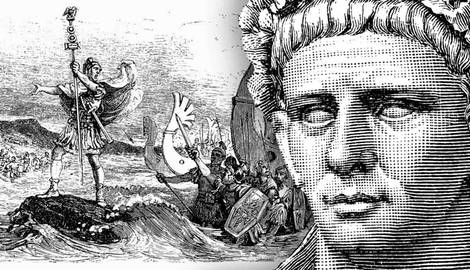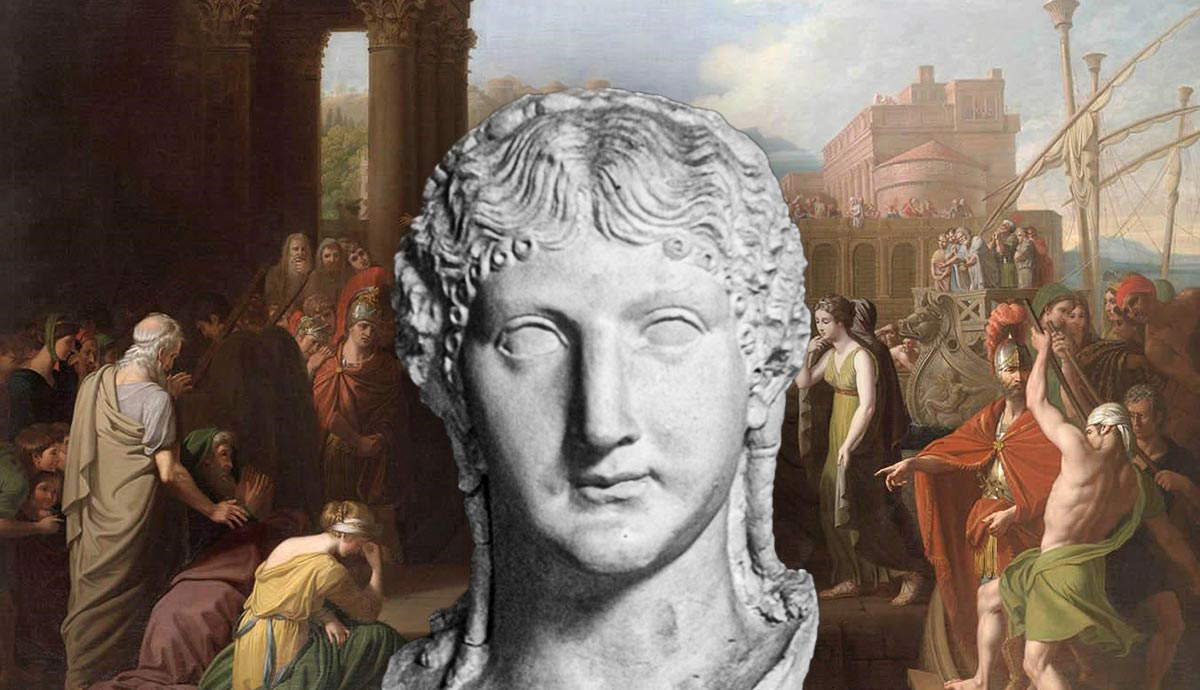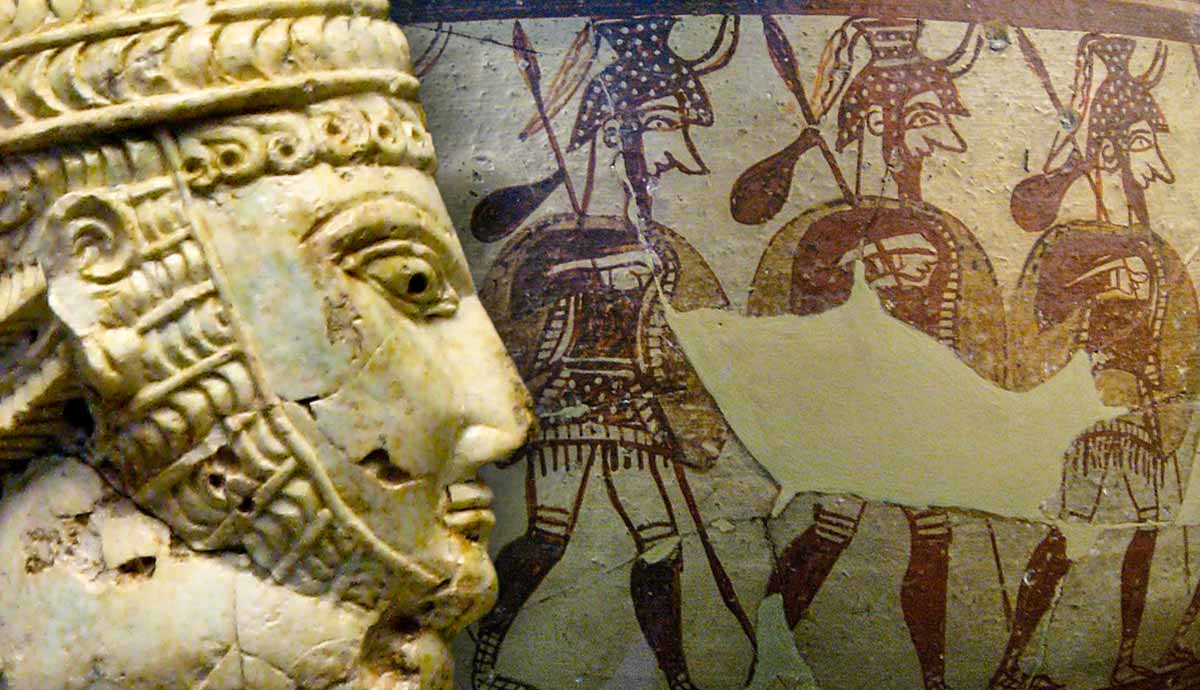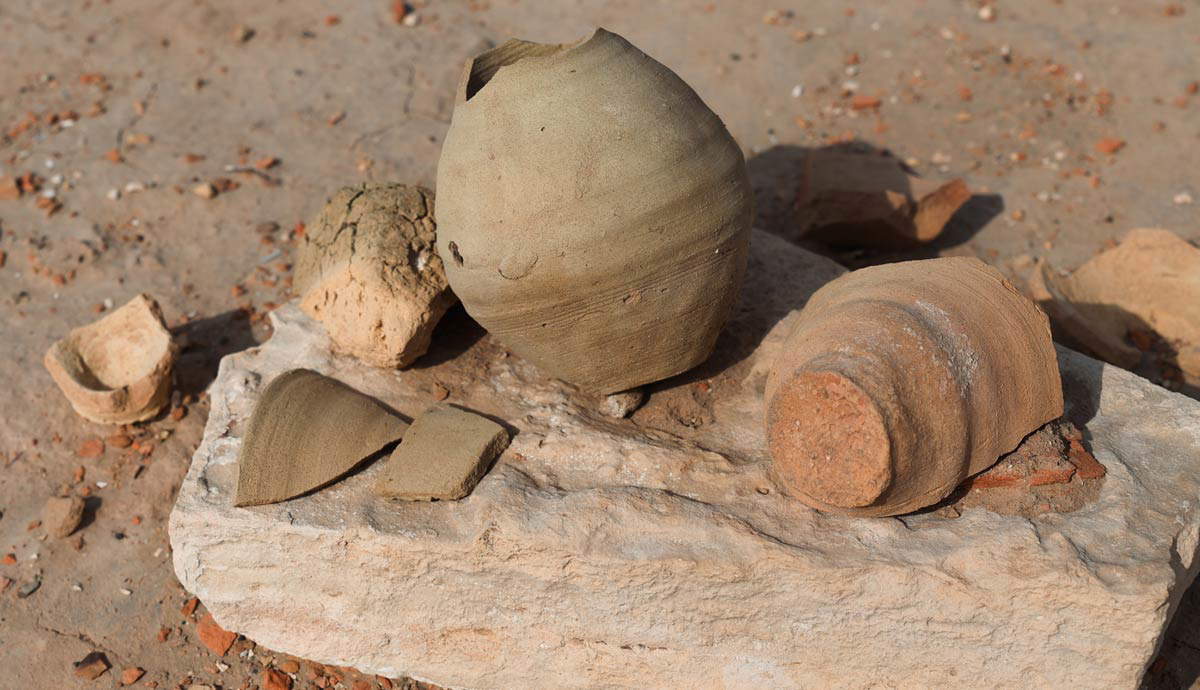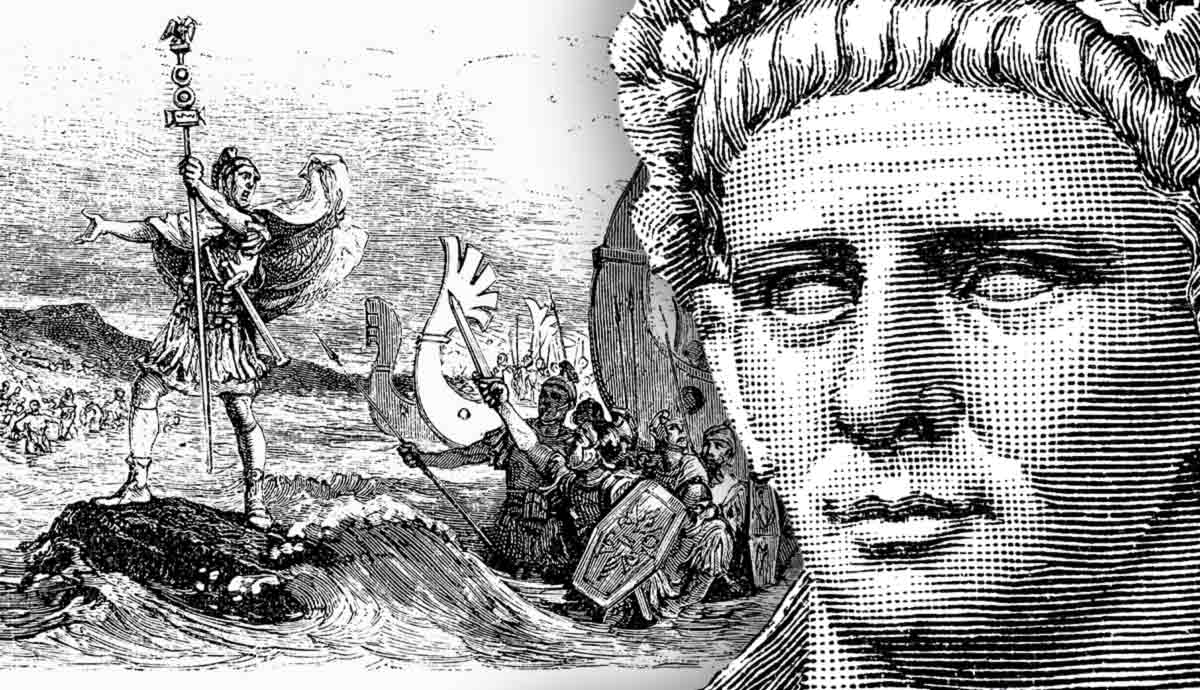
Following an aborted attempt to take the island by Julius Caesar, Britain became a standing challenge for all future leaders of Rome. But it would be almost a century before the island was finally conquered under the auspices of the emperor Claudius. While he would celebrate a triumph for the victory and build a temple to himself in his new territory, it would take another four decades to fully establish the Roman province of Britannia.
The Romans Discover Britain: Julius Caesar

While the island of Britain disconnected from the European continent 425,000 years ago, it retained close ties with the people just over the channel. As the Romans started to bring Gaul—covering modern France and parts of surrounding countries—under their sway, they learned about Britain. While it is disputed whether the people occupying Britain during the Iron Age should be called Celts, they were trading partners with the Celts in Gaul and shared cultural and religious traits. Caesar noted that the Druidic priests of Gaul traveled to Britain as a center of spiritual study.
While the Roman occupation of Gaul started in the last quarter of the 2nd century BCE, it began in earnest in 58 BCE with the Gallic Wars, conducted by the rising general Julius Caesar, who also left a written record of his conquest. As part of this occupation, Caesar set his eyes on Britain. He claimed that the Britons supported the Gallic resistance to Rome and that some fugitives had escaped over the channel. This was his justification for launching an assault on the island.

Caesar made his first attempt in the summer of 55 BCE. He gained a foothold on the coast of Kent and took hostages but was forced to leave due to damage to his ships and a general lack of preparation. Nevertheless, a 20-day holiday was declared in Rome for his achievements, and Caesar had done the reconnaissance he needed to return.
When he returned in 54 BCE, Caesar had ships built that were more suitable for channel operations and traveled with five legions and 2,000 cavalrymen. He adopted a Viking-style strategy, menacing the different tribes with his troops and demanding tribute and hostages in return for peace. He established some local leaders as allies and client kings and dealt brutally with others. However, Caesar was unable to consolidate his winnings as he was forced to withdraw completely all his troops from Britain to deal with growing unrest in Gaul and then engage in civil war for power over all of Rome.
The Final Frontier: Extending Imperial Power

Caesar’s actions in Britain brought the island into Rome’s sphere of influence. It also threw down a gauntlet, with Roman emperors wishing to prove themselves the equal of the great Julius Caesar on the battlefield setting their sights on Britain.
Augustus reportedly planned assaults on Britain in 34, 27, and 25 BCE, but they were called off due to crises elsewhere in the Empire. Augustus also maintained diplomatic relations with leaders from the island, receiving British embassies and importing luxury goods such as precious metals and wool.
Augustus reportedly advised his successor Tiberius on his deathbed not to try and expand the borders of the empire, advice that Tiberius, who had already proven himself one of Rome’s best generals during Augustus’s reign, heeded.
When Caligula came to power, it was a different story. While he was the son of the beloved general Germanicus, when he became emperor in 37 CE at 24 years of age, he had no military experience. Therefore, when an exiled member of the Catuvellauni Dynasty, one of Rome’s client kingdoms in Britain, arrived in Rome, Caligula used it as an excuse to launch an expedition.

According to the surviving sources, which are universally hostile toward the assassinated emperor, after wintering in Gaul in 40 CE, Caligula drew up his troops along the Gallic coast facing Britain and ordered them to collect seashells so that he could celebrate a triumph over the sea god Neptune back in Rome. While this is sometimes interpreted as a sign of Caligula’s mental instability, others suggest that his legions mutinied and refused to mount the invasion and that collecting seashells was meant as a punishment. Another possibility is that representatives of the Catuvellauni arrived in response to the presence of Roman troops, and the issue was resolved. Whatever the truth, the invasion was aborted.
When Caligula was assassinated in 41 CE, he was replaced by his uncle Claudius, who was in a similar position. Despite being 50 years old when he became emperor, he had no military experience as he had generally been kept out of the public eye due to some noticeable illness, perhaps cerebral palsy. He also needed to prove himself, and Britain presented an opportunity.
Claudius’s Invasion of Britain

Verica was the king of the Atebates tribe in Britain, a tribe that had been allied with Rome since the time of Julius Caesar. His territory was being encroached upon by the Catuvellauni, led by the brothers Togodumnus and Caratacus, who had become hostile to Roman influence. Verica was expelled from Britain in 42 CE. He seems to have turned to Rome for help. Claudius agreed partly to contain the increasingly powerful Catuvellauni threat and, no doubt in part, to establish his military credentials.
Claudius did not lead the invasion force himself, instead entrusting it to the general Aulus Plautius. It is unclear how large an army he led, though it is estimated that he had around 20,000 Roman soldiers and a similar number of auxiliaries, including cavalry. The future emperor Vespasian was among his commanders.
According to Cassius Dio (60.19), there was a mutiny before the invasion could launch, with the men refusing to sail over the sea beyond the limits of the known world. This may relate to a story told by Tacitus (Annales 2.24) of ships blown off course to Britain in 16 CE returning with tales of monsters and inexplicable sea phenomena. The same stories may have been behind Caligula’s troops refusing to make the crossing.

Eventually, the troops set sail in three divisions, which was necessary to transport a large number of troops and organize the sequenced landing of hundreds of ships. Their principal landing site was probably at Richborough in Kent, which represents only a short crossing and where a Roman fortification of Claudian date has been uncovered.
Cassius Dio suggests that the Romans defeated the Catuvellauni and their allies in two battles. The first was at a river crossing that saw the Roman cavalry swimming across with their horses to outflank the Britons. The location of the battle is disputed and could have been on the River Medway or Arun. The second battle was almost certainly on the Thames and was a major victory for the Romans. Togodumnus was killed, and Caracatus was forced to flee. The victory seems to have been sufficiently decisive that Plautius considered it safe to send for Claudius, who arrived with reinforcements, artillery, and even elephants.

This enlarged force marched on the Catuvellauni capital, Camulodunum (Colchester), no doubt using the war elephants to terrify the Britons into submission. This strategy seems to have worked as, according to Cassius Dio, eleven British kings surrendered to Claudius. The emperor returned to Rome after spending just 16 days in Britain. Claudius was voted a triumph; he erected a triumphal arch to commemorate the occasion, and he gave his young son the honorific name Britannicus.
Just six years later, Roman veterans began construction of the new capital of Roman Britain on the site of Camulodunum. Among other things, they built a Senate house, a theater, and a temple and altar dedicated to the living Emperor Claudius. The temple was an enormous octastyle edifice, discovered beneath the remains of an 11th-century Norman castle. Rome was making its mark on its new province.
Expansion and Revolts

While Claudius’s triumph for the conquest of Britain happened in 43 CE, it would take four more decades to subdue the new Roman province. While the Romans had a strong foothold in the former Catuvelluani territory in the south and southeast and had secured East Anglia through treaties and client kingdoms, the regions of Cornwall, Wales, and the north remained beyond Roman control.
Aulus Plautius remained in Britain as the governor of the new province until 47 CE. He led campaigns that took the hill forts of Dorset and eventually all the territory between the Humber and Severn Estuaries. Plautius was succeeded by Ostorius Scapula, who finally captured Caratacus in 51 CE, who had been leading guerrilla attacks against the Roman forces for years. Caratacus was sent to Italy, where he was held as a hostage until he died.

Scapula was succeeded as governor by Didius Gallus and then Quintus Veranus, both of whom led campaigns west into Wales. But the next major incident happened when Suetonius Paulinus was governor, after the death of Claudius and the succession of his adopted heir Nero. He led an attack on the druid stronghold of Anglesey as part of a more concerted campaign to occupy Wales. He reportedly massacred the druids there and set their sacred sites on fire. However, his campaigning in Wales was cut short by the Iceni revolt.
Now infamously, when the Iceni leader and client king Prasutagus revolted, he left half of his kingdom to Nero and half to his daughters, hoping to retain some independence. But the Romans seized all his land, and when his widow Boudicca objected, he humiliated the ruling family by flogging and raping her daughters. In retaliation, Boudicca summoned an alliance of tribes around her and attacked and destroyed the Roman colony at Camulodunum, followed by Londinium and Verulamium (St Albans). The Iceni rebels reportedly killed 70-80,000 people in those three cities.

Paulinus managed to rally his forces and defeat Boudicca in the Battle of Watling Street in 61 CE, which resulted in Boudicca’s suicide and the end of the revolt. While this threat to Roman power was short-lived, the death toll was high enough that Nero reportedly considered abandoning Britain altogether.
The New Roman Province

The Roman civil war of 69 CE gave the Britons another chance to revolt, this time led by Venutius of the Brigantes. But with Vespasian taking the helm of the empire at the end of 69 CE, he made a concerted effort to pacify the new province on which he had previously served.
Vespasian first sent his former son-in-law Quintus Petillius Cerialis as the new governor. He had previously participated in putting down the Iceni rebellion and had just dealt with the Batavian Rebellion in Germania in 70 CE and therefore represented a safe, experienced, and trustworthy pair of hands. He was succeeded in 74 CE by Sextus Julius Frontinus, who successfully extended Roman rule to all of South Wales. It was under Frontinus that the grand Roman villa at Fishbourne was constructed, the largest Roman residence north of the Alps.

Vespasian’s final appointment in Britain was Gnaeus Julius Agricola, the father-in-law of the Roman writer Tacitus, who wrote a biography of the general, preserving details of his British campaigns. Having already served in Britain as a commander twice, he was made governor in 77 CE. He took northern Wales from the Ordovices tribe in 78 CE and then turned north towards Scotland and the Caledonians. In 84 he had a major victory there at the Battle of Mons Graupius. This put the entire island within Rome’s reach, and he had ships circumnavigate the top of Scotland to prove the limits of the island. However, the Caledonians hid in the highlands and marshlands, where they continued to resist, preventing a decisive victory.
Agricola was recalled to Rome in 85 CE, according to Tacitus, because the new emperor, Domitian, was jealous of his military exploits, which were much greater than Domitian’s own. While Tacitus was an eyewitness and probably knew the mind of his father-in-law, this accusation does not track. Agricola was awarded triumphal ornamentation and a statue for his achievements, which was the highest possible honor for a general who was not a member of the imperial family. He was also allowed to stay in Britain for an unusually long time and was offered further posts after his return, which he seems to have turned down due to poor health. Tacitus was probably right that Agricola was angry when Domitian pulled a large number of troops out of Britain in 87 CE, forcing them to bring the border back 120 kilometers (75 miles), losing much of the territory that had been gained. But those forces were needed to deal with trouble elsewhere in the empire.

It was this strategic retreat that more-or-less set the border of Roman Britain. It was always a volatile province where revolts were common, and a strong military presence was required. When Hadrian visited the province in 120 CE, he ordered a wall built across the northern border, now famously known as Hadrian’s Wall. This border was briefly pushed further north, as reflected by the construction of the Antonine Wall around 142 CE, but they would move south again within two decades.
The Romans certainly left their mark on Britain. The following centuries saw the adoption of Roman names, words, and writing, the proliferation of Roman material culture, and the integration of local and Roman religious practices. And this was all made possible by the emperor Claudius, who spent just 16 days on the island.
